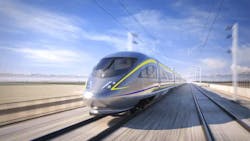CHSRA celebrates Earth Day by highlighting sustainability efforts on high-speed rail project
The California High-Speed Rail Authority (CHSRA) celebrated Earth Day on April 22 by highlighting significant sustainability milestones achieved over the past year. CHSRA says the high-speed rail program is delivering one of the most significant and greenest infrastructure projects in the U.S.
“In the spirit of Earth Day, the authority recognizes sustainability as the very core of an electrified, high-speed rail system – an overall critical component of an economically dynamic and carbon-neutral transportation future,” said CHSRA Director of Planning and Sustainability Margaret Cederoth. “Even in construction, we’re committed to advancing this program cleanly, with the authority’s policies and practices leading us to reduce or avoid more equivalent emissions in the Central Valley than have been created so far.”
Clean construction practices
- Requiring efficient construction equipment mandates, requiring all contractors working on the high-speed rail system to use equipment that reduces air pollution.
- Planting trees to offset emissions and provide residents shade, resulting in significant greenhouse gas reductions.
- Diverting 95 percent of all waste from landfills through recycling, reusing and composting of non-hazardous materials.
- Pledging through the Voluntary Emissions Reduction Agreements (VERA) program to offset each ton of air pollutant emitted during construction within local air quality districts.
- Minimizing impacts to wildlife by building rail alignment on elevated viaducts, bridges and crossings to allow unobstructed passage by animals and waterways.
- Tracking the greenhouse gas and air quality emissions construction generates, aiming to achieve net-zero emissions by creating more offsets than emissions during construction.
Economic and community impact
- Driving economic growth and job creation, with 99 percent of expenditures going to California businesses and workers, two-thirds of which are benefiting disadvantaged communities.
- Employing 1,600 construction workers daily.
- Empowering more than 250 individuals who have graduated from the Central Valley Training Center in Selma.
- Creating more than 15,000 jobs, with more than 25 construction sites along 119 miles of active construction.
Sustainability and natural resources conservation
- Prioritizing pedestrian access and integration with other transit systems to create regional, intermodal hubs, making high-speed rail stations magnets for sustainable development to curb suburban sprawl.
- Working with local cities to develop station area plans ensuring stations reflect and complement existing communities while driving economic growth.
- Protecting a total of 3,190 acres to date of farmland through conservation easements.
- Preserving and restoring more than 4,400 acres of open land, including 151 acres of wetlands, to mitigate impacts of building the system.
In March, the authority revealed next steps in securing a Central Valley Photovoltaic and battery energy storage system, which will produce and store energy in battery systems to ensure uninterrupted rail operations and enhance energy resilience, lower operational costs and reduce reliance on the traditional power grid.
The high-speed rail system will operate on 100 percent renewable energy. CHSRA says construction of the high-speed rail project is happening daily. There are currently 171 miles under design and construction from Merced to Bakersfield.
